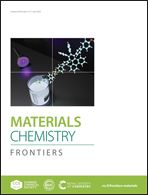A responsive AIE-active fluorescent probe for visualization of acetylcholinesterase activity in vitro and in vivo†
Abstract
Acetylcholinesterase (AChE) is a significant enzyme, which plays critical roles in numerous physiological and pathological processes. Thus, selective, and sensitive real-time imaging of AChE activity in vivo has great importance to further understand its contribution to cellular activities and to develop diagnostic tools for several disease states including neurodegenerative disorders and cancer. To this end, we introduced an AChE selective light up fluorescent probe (TCFPB-AChE) with aggregation induced emission (AIE) characteristics to visualize AChE activity both in vitro and in vivo. TCFPB-AChE displayed a selective turn-on fluorescence response upon addition of AChE with a very low detection limit. TCFPB-AChE was further used to image endogenous AChE activity in a glioblastoma cell line and Alzheimer's disease mice brain tissue with a high signal to noise ratio. In addition to these, the probe was also utilized to visualize varying concentrations of AChE in living mice brains in vivo. Remarkably, TCFPB-AChE marks the first ever example of an AChE responsive AIE-based fluorescent probe.

- This article is part of the themed collection: FOCUS: Recent progress on aggregation-induced emission


 Please wait while we load your content...
Please wait while we load your content...